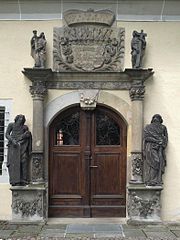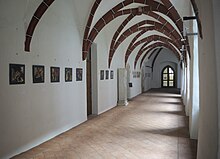St. Afra Monastery (Meissen)
The Augustinian canons of St. Afra in Meißen was founded in 1205 by Bishop Dietrich II of Kittlitz . In the course of the Reformation , the institution was secularized. In 1543 the first princely and state school in Saxony was founded in the buildings . The former monastery has also housed the Evangelical Academy of the Evangelical Lutheran Regional Church of Saxony , founded in 1949 .
history
A document from 1205 reports the establishment of the Augustinian Canons' Monastery of St. Afra in Meißen. Bishop Dietrich II of Kittlitz (1191–1208) of Meißen called monks from the monastery on the Lauterberg (Petersberg) near Halle / Saale. Johann Friedrich Ursinus reports that Bishop Dietrich I (1024-1046) was the fundator Affrae . This can only be the already existing predecessor. The monastery was an episcopal monastery. A school was attached to it early on.
With the Reformation , which was carried out in Saxony by Duke Heinrich from 1539 , the monastery was dissolved. The last provost Nikolaus Klunker renounced the prelature and handed over the monastery property to the sovereign commissioners in 1540.
Elector Moritz established the first princely and state school in Saxony in 1543 . She was named St. Afra. The church became a parish and at the same time a school church until 1943.
Since 1999 the three previous Evangelical Lutheran parishes on the old town side of Meissen (St. Afra, Frauenkirche and Lutherkirche) have been under the name Ev.-luth. Parish of St. Afra, Meissen. In this way, the name St. Afra is only linked to a Christian liveliness. St. Afra was borrowed for the state school, elementary school and a special black beer brewed in the Meissen sword brewery .
Exterior view of the Penitence Tower
St. Afra Church
Previous construction
The Augustinian Canons' Monastery was set up around the older St. Afra Church. It was one of the oldest parish churches in Saxony. The first mention of a church at this point comes from 984. The predecessor of today's church, an elongated hall church with an apse in the east, was proven in 1966 by excavation.
Building history of today's church
After the foundation of the monastery, the church on the Afraberg was rebuilt as a late Romanesque basilica. After the middle of the 14th century the choir walls were raised and the choir closed with four ribbed vaults. The main nave received a Gothic vault with five bays after 1470 . Until then, the ship had a straight wooden beam ceiling. After a lightning strike in 1766, the tower was given a baroque dome.
Worth seeing details
- The pulpit and the baroque carved altar were created by Valentin Otte (around 1660).
- The Martin Altar was originally set up in the St. Martin Church in Weinböhla . It is the work of an unknown master from the late Gothic period from 1503. Today we find the altar structure on the west wall of the Afra Church. The figures in the middle part embody St. Martin with St. Urban and the Evangelist Johannes . The paintings on the side wings show other saints: On the left wing you can see the mercy seat above and Saint Barbara below . Unfortunately the paintings on the left are not completely preserved. On the right wing St. Hieronimus is depicted at the top, St. Elisabeth and St. Nicholas at the bottom . The predella shows Veronica's handkerchief .
- The early baroque portal on the south side was built around 1670. Depicted on the left is Moses with the tablets of the law, above the symbolized synagogue and on the right the Apostle Paul with sword, above the symbolized church (Ecclesia). In the middle is the majesty coat of arms of the Saxon electors with the electoral hat.
- The vestibule with the rich cell vault dates from the late Gothic period.
- The Schleinitz Chapel is a burial chapel of the Schleinitz family , a knight family from the 15th and 16th centuries. The chapel was added to the church later, in 1408 by Hugold v. Schleinitz donated and consecrated as a chapel of the holy body of Christ. Around 1470 a yoke was added to the west. There are tombstones from the Gothic and epitaphs from the Renaissance .
organ
Today's organ was created by Friedrich Gotthelf Pfützner in 1847 and revised by Hermann Eule in 1908; it was extensively restored in 2015 by Mitteldeutscher Orgelbau A. Voigt GmbH from Bad Liebenwerda. It has 2 manuals and 34 stops.
literature
- Karsten Vogt (Meißen): Organs in Saxony - The restoration of the organ in St. Afra in Meißen . In: EvLKS -Arbeitsstelle Kirchenmusik, director: Markus Leidenberger (Hrsg.): Klanggut - a magazine about church music in Saxony . tape 1-2019 . EVLKS office for church music, Dresden 2019, p. 19–22 (page 22 - there also the disposition of this organ).
Individual evidence
- ↑ Latin document text
- ↑ Theological Real Encyclopedia. Vol. 29 Berlin, 1998, p. 563.
- ↑ History of St. Afra Church Website of the parish
- ↑ https://orgelbau.de/ - accessed on June 30, 2019
- ^ Karsten Vogt (Meißen): Organs in Saxony - The restoration of the organ in St. Afra in Meißen . In: EvLKS -Arbeitsstelle Kirchenmusik, director: Markus Leidenberger (Hrsg.): Klanggut - a magazine about church music in Saxony . tape 1-2019 . EVLKS office for church music, Dresden 2019, p. 19-22 .
Web links
- History of the monastery Website of the evangelical academy in Meißen
- Klanggut - Journal of Church Music in Saxony , Issue 1 - 2019 for download (pdf), see p. 19–22 (disposition of this organ: p. 22), accessed on June 30, 2019
Coordinates: 51 ° 9 ′ 53.3 " N , 13 ° 28 ′ 5" E







